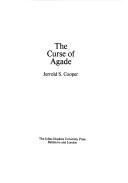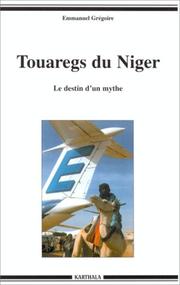| Listing 1 - 6 of 6 |
Sort by
|

ISBN: 0801828465 Year: 1983 Publisher: Baltimore Johns Hopkins university press
Abstract | Keywords | Export | Availability | Bookmark
 Loading...
Loading...Choose an application
- Reference Manager
- EndNote
- RefWorks (Direct export to RefWorks)
Babylonia --- -History --- -Poetry --- Curse of Agade. --- Vavilonii︠a︡ --- Bavel --- Bābil --- Babylonien --- Sumer --- History --- Poetry.
Book
ISBN: 0897571045 Year: 1980 Publisher: Cambridge American schools of Oriental research
Abstract | Keywords | Export | Availability | Bookmark
 Loading...
Loading...Choose an application
- Reference Manager
- EndNote
- RefWorks (Direct export to RefWorks)
Abandoned children in literature --- Assyro-Babylonian literature --- -Heroes in literature --- Akkadian literature --- Babylonian literature --- History and criticism --- Abandoned children in literature. --- Heroes in literature. --- History and criticism. --- Heroes in literature --- Sargon --- Sargon of Agade --- In literature. --- Legend of Sargon. --- Legend concerning the birth and infancy of Sargon I, King of Agade --- Legend of the birth of Sargon of Agade --- Mythological legend concerning the birth and infancy of King Sargon I --- Sargon birth legend
Book
ISBN: 3631796846 3631795122 9783631796849 9783631796856 9783631796863 9783631795125 3631796854 Year: 2020 Publisher: Bern Peter Lang International Academic Publishing Group
Abstract | Keywords | Export | Availability | Bookmark
 Loading...
Loading...Choose an application
- Reference Manager
- EndNote
- RefWorks (Direct export to RefWorks)
This book analyses the ways of conceptualising and interpreting the interaction between physical and metaphysical worlds in Polish folklore. A linguistic and anthropological analysis offered in this study focuses primarily on myth, ritual and symbol as reflected in language (dialect lexis, phraseology, speech acts). Employing the methodology and analytical tools of cognitive linguistics (preconceptual image schemas, cognitive scene, profiling of concepts, development of cognitive paths), the author reconstructs mental patterns at the heart of mythical thinking, linguistic actions and symbolic meanings, which reflect universal conceptual schemas and may serve as models for intercultural studies.
Folklore --- [2nd --- Agade --- Cognitive --- edition] --- extraterrestrial --- Four natural elements --- języku --- kulturze --- Linguistic --- Linguistic stereotypes --- Ludowe --- Masłowska --- Mediating --- Metaphysical worlds --- obcowania --- Otherworld --- Perspective --- Polish --- Polish folk --- polskiej --- Preconceptual image schemas --- reality --- revised --- stereotypy --- świata --- Symbolic thinking --- Wydawnictwo --- zaświatów
Book
ISBN: 9781934309124 1934309125 1934309400 9781934309407 Year: 2009 Volume: 13 Publisher: Bethesda CDL
Abstract | Keywords | Export | Availability | Bookmark
 Loading...
Loading...Choose an application
- Reference Manager
- EndNote
- RefWorks (Direct export to RefWorks)
Bismaya (Iraq) --- Cuneiform tablets --- Akkadian language --- Sumerian language --- Sargon --- Naram-Sin, --- Cornell University. --- Adab (Extinct city) --- Babylonia --- Antiquities. --- Tablets, Cuneiform --- Clay tablets --- Cuneiform writing --- Sargon of Agade --- Naramsîn, --- Cornell University --- Bismya (Iraq) --- Iraq --- Antiquities --- Texts --- Cuneiform tablets - Iraq - Adab (Extinct city) --- Akkadian language - Texts --- Sumerian language - Texts --- Sargon - I, - King of Agade --- Naram-Sin, - King of Babylonia, - approximately 2254 B.C.-approximately 2218 B.C. --- Babylonia - Antiquities --- Bismaya (Iraq) - Antiquities --- Babylonia - Antiquities. --- -Umma (Extinct city) --- Isin (Extinct city) --- Umma (Extinct city)

ISBN: 2865379663 Year: 1999 Publisher: Paris Karthala
Abstract | Keywords | Export | Availability | Bookmark
 Loading...
Loading...Choose an application
- Reference Manager
- EndNote
- RefWorks (Direct export to RefWorks)
Tuaregs --- Touaregs --- Agadez (Niger : Dept.) --- Agadès (Niger : Département) --- Economic conditions --- Conditions économiques --- Economic conditions. --- History. --- Social conditions. --- Agadès (Niger : Département) --- Conditions économiques --- Tuariks --- Berbers --- Ethnology --- History --- Social conditions --- Agadez (Niger : Département) --- Politics and government. --- Agades (Niger : Department)
Book
ISBN: 3631807627 3631807635 3631802013 Year: 2020 Publisher: Bern Peter Lang International Academic Publishing Group
Abstract | Keywords | Export | Availability | Bookmark
 Loading...
Loading...Choose an application
- Reference Manager
- EndNote
- RefWorks (Direct export to RefWorks)
The book discusses the sociolinguistic status and prestige of the Polish language and the changes in the national identity of Catholics in Belarus due to the switch from Polish to Belarusian in the Catholic Church. The research shows that the national identification of Catholics in Belarus is changing. The oldest generations most often self-identify as Polish. For those from the middle and youngest generations, the link between nationality and their religion is not obvious as being a Catholic does not exclude a Belarusian self-identity. Belonging to the Catholic Church results from being baptized in the Catholic rite, while national identity can be defined in many ways and re-defined by various life experiences. Catholicism has proven to be a less debated and more durable category than nationality.
Language question in the church --- Catholic Church --- Liturgy. --- Church --- Language and languages --- Religious aspects --- Christianity --- Church of Rome --- Roman Catholic Church --- Katholische Kirche --- Katolyt︠s︡ʹka t︠s︡erkva --- Römisch-Katholische Kirche --- Römische Kirche --- Ecclesia Catholica --- Eglise catholique --- Eglise catholique-romaine --- Katolicheskai︠a︡ t︠s︡erkovʹ --- Chiesa cattolica --- Iglesia Católica --- Kościół Katolicki --- Katolicki Kościół --- Kościół Rzymskokatolicki --- Nihon Katorikku Kyōkai --- Katholikē Ekklēsia --- Gereja Katolik --- Kenesiyah ha-Ḳatolit --- Kanisa Katoliki --- כנסיה הקתולית --- כנסייה הקתולית --- 가톨릭교 --- 천주교 --- Agade --- Belarus --- Białorusi --- Boga? --- Catholic church in Belarus --- Catholics --- Centuries --- Conversations --- Early --- Golachowska --- katolików --- language of religion --- Late --- mówić --- Multilingualism --- national identification --- Pana --- Polish in Belarus --- przełomie --- Sociolinguistic --- sociolinguistics --- study --- Twentieth --- Twenty --- wieku --- wielojęzyczność --- Wydawnictwo
| Listing 1 - 6 of 6 |
Sort by
|

 Search
Search Feedback
Feedback About UniCat
About UniCat  Help
Help News
News